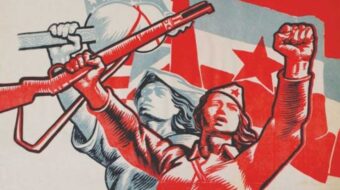
March 8, International Women’s Day, grew from the struggle of working women to form trade unions and the fight for women’s right to vote.
On March 8, 1857, garment workers in New York City marched and picketed, demanding improved working conditions, a ten-hour day, and equal rights for women. The police broke up their ranks. Fifty-one years later, March 8, 1908, their sisters in the needle trades in New York marched again, honoring the 1857 march, demanding the vote, and an end to sweatshops and child labor.
This historic demonstration led in the following year to an “uprising” of 30,000 women shirtwaist-makers that resulted in the first permanent trade unions for U.S. women workers.
News of the heroic fight by U.S. women workers reached Europe. In particular it inspired European socialist women who had established the International Socialist Women’s Conference on the initiative of German socialist and activist for women’s rights Clara Zetkin (1857-1933).
In 1910 Zetkin made a motion to the Copenhagen Conference of the Second International for demonstrations in every country on behalf of women’s rights and the first International Women’s Day was held in 1911.
Rallies and demonstrations in the US and many European countries marked International Women’s Day in the years leading to World War I, including a call for peace.
Clara Zetkin saw that the struggle for women’s rights was firmly tied into the struggle for socialism, and that socialism would be impossible to achieve without the active involvement of women.
In 1917 in Russia, International Women’s Day became the flashpoint for the Russian Revolution. On March 8 women workers in Petrograd held a massive strike and demonstration demanding “peace and bread” which spread from factory to factory.
March 8 became a national holiday in many countries but was largely ignored here in the U.S.
In 1975 — International Women’s Year-the United Nations recognized March 8 as International Women’s Day. The UN theme for 2014 is “Equality for Women is Progress for All.”
The United States ranks 23rd globally in gender equality. Women make only 77 cents for every dollar a man makes. Women, especially women of color, are the majority of low wage and tipped workers. Forty percent of women in our country are the main or sole breadwinner for their families. The campaigns for pay equity and to raise the minimum wage are important to women and all workers here and globally.
In the famous 1912 Lawrence, Mass., textile strike, women carried picket signs reading “We want Bread and Roses, too”, symbolizing their demands for not only a living wage but a decent and human life, inspiring the song “Bread and Roses”
As we come marching, marching, in the beauty of, the day
A million darkened kitchens, a thousand mill lofts gray
Are touched with all the radiance that a sudden sun discloses
For the people hear us singing, Bread and Roses, Bread and Roses
As we come marching, marching, we bring the greater days
The rising of the women means the, rising of the race
No more the drudge and idler that toil where one reposes
But a sharing of life’s glories, Bread and Roses, Bread and Roses
Photo: unwomen.org












Comments